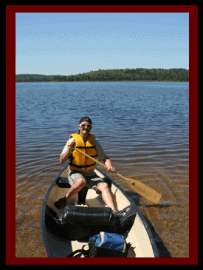Wabakimi Wilderness Provincial Park

Park Size: 892,000 hectares
Park Amenities:
Wabakimi Provincial Park is a North of Superior wilderness adventure destination located west of the community of Armstrong, Ontario, Canada. The Wabakimi Park is the second largest park in Ontario, as well as, one of the largest boreal forest parks in Canada
The boreal forest of the park provides a wide sample of forest cover. Some of the trees in the park include jackpine, aspen. white birch, white and black spruce. Other sections of the park are, either, covered in waterways or exposed bedrock from the Canadian Shield.
The park was first established in 1983. In the mid 1970s the park boundaries were expanded further to protect the sensitive wetland eco systems, rock formations and the breeding area of the Woodland Caribou. Today... the park measures 892,000 hectares (2.3 million acres).
The name Wabakimi originates from a combination of words taken from the language of the Ojibway First Nation people. The Ojibway word of "Waubishkaugimi" means "whitewater" and "Wabishkkegin" means "the sheet of white".
The Ojibway First Nation people have paddled the waterways of the park for centuries. The current canoes routes in the park follow along the same routes as the Ojibway once traveled. Along the routes are evidence of historic villages, artifacts and pictographs (rock paintings).
The wilderness environment, the waterways, the wildlife sightings and the remote lodges, wilderness campsites and fly-in camps make the Wabakimi Wilderness Provincial Park popular for canoeing, hunting, birdwatching and fishing for perch, walleye, whitefish, northern pike and lake trout.
It is said there are over 500+ wilderness campsites and 2,000+ kilometres of paddle routes in the park. Some of the main and most popular paddle routes include the Allanwater, Pikitigushi, and Ogoki Rivers. All with portages bypassing white water rapids.
The river and lake networks of the park extend paddle routes into other wilderness adventure parks. To the north is the Albany River... and to the south are the Brightsand River and the Kopka River Provincial Parks. The park is recognized as one of the most extensive paddle route destinations in the world.
Local outfitters and resort operators provide the tools for a successful venture into the park including accommodations, guided tours, equipment, maps, paddle routes, fishing and hunting permits and transportation services.
Adventures in the park are only accessed via floatplane, train, canoe and kayak. There is no road or hiking trail access into the park.
While exploring the park it is vital to have a camera ready and available as their are opportunities for wildlife sightings. Some of the wildlife sightings in the park include moose, woodland caribou, wolves, black bear, beaver, otter, mink, fox and many bird species like bald eagles, boreal owl, osprey and loon.
Explore Wabakimi Wilderness Provincial Park, Armstrong, Ontario, North of Superior, Canada
Address:
How To Get ToWabakimi Wilderness Provincial Park
:Rail : A train (some call it a bush train) travels into the park and provides access to adventures. Reservations are required. Contact Rail Station : 1.888.842.7245 (upgrade to a Photo Listing with website links)
Air : Floatplane charter companies provide air travel to remote lodges and outposts in the park.
Water : Canoe routes follow waterways into the park.



